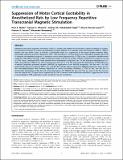| dc.contributor.author | Muller, Paul A. | en_US |
| dc.contributor.author | Dhamne, Sameer C. | en_US |
| dc.contributor.author | Vahabzadeh-Hagh, Andrew M. | en_US |
| dc.contributor.author | Pascual-Leone, Alvaro | en_US |
| dc.contributor.author | Jensen, Frances E. | en_US |
| dc.contributor.author | Rotenberg, Alexander | en_US |
| dc.date.accessioned | 2014-04-11T14:12:38Z | |
| dc.date.issued | 2014 | en_US |
| dc.identifier.citation | Muller, Paul A., Sameer C. Dhamne, Andrew M. Vahabzadeh-Hagh, Alvaro Pascual-Leone, Frances E. Jensen, and Alexander Rotenberg. 2014. “Suppression of Motor Cortical Excitability in Anesthetized Rats by Low Frequency Repetitive Transcranial Magnetic Stimulation.” PLoS ONE 9 (3): e91065. doi:10.1371/journal.pone.0091065. http://dx.doi.org/10.1371/journal.pone.0091065. | en |
| dc.identifier.issn | 1932-6203 | en |
| dc.identifier.uri | http://nrs.harvard.edu/urn-3:HUL.InstRepos:12064483 | |
| dc.description.abstract | Repetitive transcranial magnetic stimulation (rTMS) is a widely-used method for modulating cortical excitability in humans, by mechanisms thought to involve use-dependent synaptic plasticity. For example, when low frequency rTMS (LF rTMS) is applied over the motor cortex, in humans, it predictably leads to a suppression of the motor evoked potential (MEP), presumably reflecting long-term depression (LTD) – like mechanisms. Yet how closely such rTMS effects actually match LTD is unknown. We therefore sought to (1) reproduce cortico-spinal depression by LF rTMS in rats, (2) establish a reliable animal model for rTMS effects that may enable mechanistic studies, and (3) test whether LTD-like properties are evident in the rat LF rTMS setup. Lateralized MEPs were obtained from anesthetized Long-Evans rats. To test frequency-dependence of LF rTMS, rats underwent rTMS at one of three frequencies, 0.25, 0.5, or 1 Hz. We next tested the dependence of rTMS effects on N-methyl-D-aspartate glutamate receptor (NMDAR), by application of two NMDAR antagonists. We find that 1 Hz rTMS preferentially depresses unilateral MEP in rats, and that this LTD-like effect is blocked by NMDAR antagonists. These are the first electrophysiological data showing depression of cortical excitability following LF rTMS in rats, and the first to demonstrate dependence of this form of cortical plasticity on the NMDAR. We also note that our report is the first to show that the capacity for LTD-type cortical suppression by rTMS is present under barbiturate anesthesia, suggesting that future neuromodulatory rTMS applications under anesthesia may be considered. | en |
| dc.language.iso | en_US | en |
| dc.publisher | Public Library of Science | en |
| dc.relation.isversionof | doi:10.1371/journal.pone.0091065 | en |
| dc.relation.hasversion | http://www.ncbi.nlm.nih.gov/pmc/articles/PMC3960125/pdf/ | en |
| dash.license | LAA | en_US |
| dc.subject | Biology and Life Sciences | en |
| dc.subject | Anatomy | en |
| dc.subject | Nervous System | en |
| dc.subject | Motor System | en |
| dc.subject | Biochemistry | en |
| dc.subject | Neurochemistry | en |
| dc.subject | Neuromodulation | en |
| dc.subject | Neuroscience | en |
| dc.subject | Organisms | en |
| dc.subject | Animals | en |
| dc.subject | Vertebrates | en |
| dc.subject | Mammals | en |
| dc.subject | Rodents | en |
| dc.subject | Rats | en |
| dc.subject | Physiology | en |
| dc.subject | Electrophysiology | en |
| dc.subject | Nervous System Physiology | en |
| dc.subject | Model Organisms | en |
| dc.subject | Animal Models | en |
| dc.subject | Specimen Preparation and Treatment | en |
| dc.subject | Mechanical Treatment of Specimens | en |
| dc.subject | Specimen Disruption | en |
| dc.subject | Electroporation | en |
| dc.title | Suppression of Motor Cortical Excitability in Anesthetized Rats by Low Frequency Repetitive Transcranial Magnetic Stimulation | en |
| dc.type | Journal Article | en_US |
| dc.description.version | Version of Record | en |
| dc.relation.journal | PLoS ONE | en |
| dash.depositing.author | Pascual-Leone, Alvaro | en_US |
| dc.date.available | 2014-04-11T14:12:38Z | |
| dc.identifier.doi | 10.1371/journal.pone.0091065 | * |
| dash.contributor.affiliated | Rotenberg, Alexander | |
| dash.contributor.affiliated | Pascual-Leone, Alvaro | |


